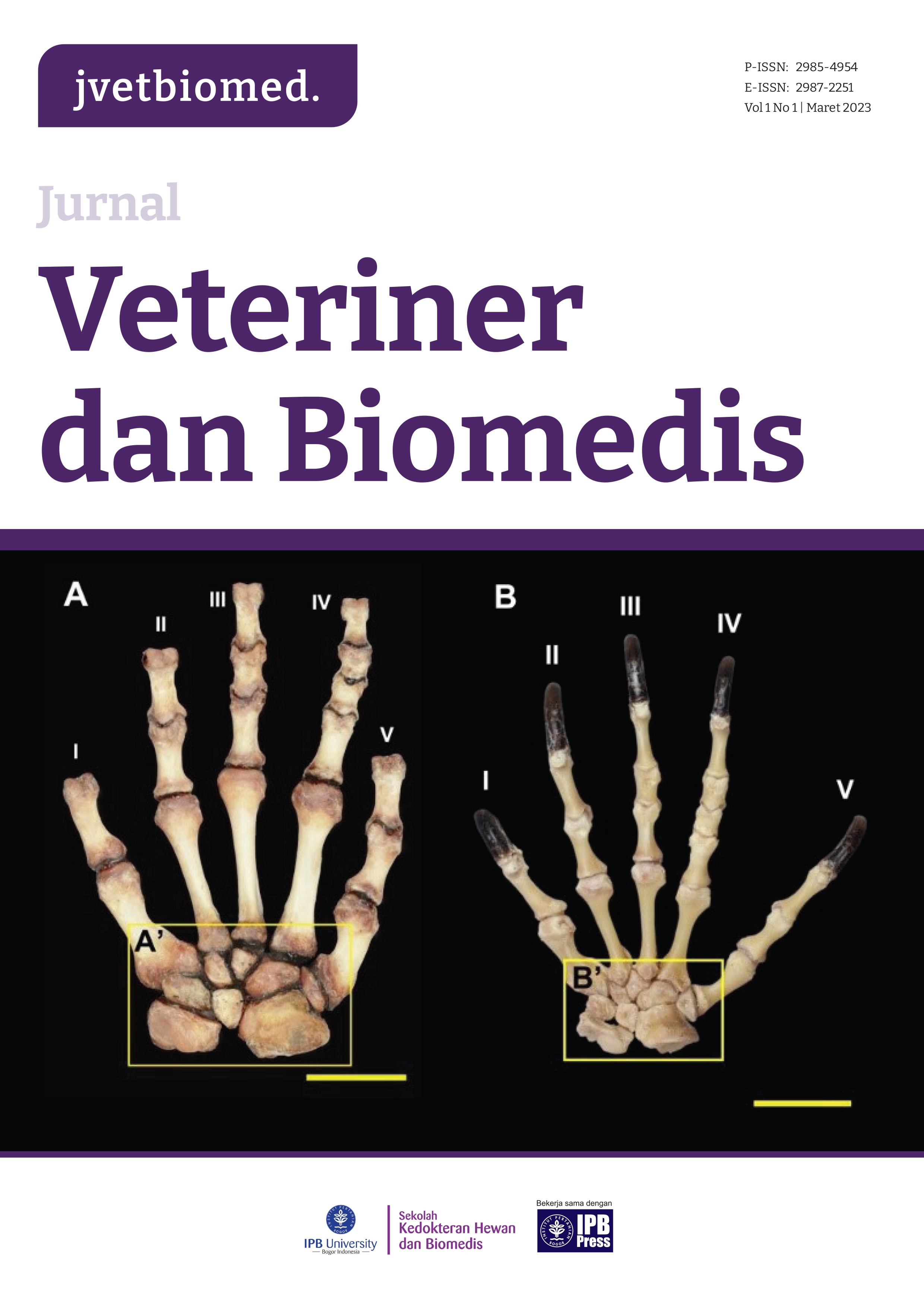Potensi Ekstrak Buah dan Daun Labu Siam (Sechium edule) sebagai prebiotik bakteri lactobacillus casei
DOI:
https://doi.org/10.29244/jvetbiomed.1.1.29-36.Keywords:
Prebiotik, Probiotik, Labu Siam (Sechium edule), Lactobacillus caseiAbstract
Lactobacillus casei merupakan salah satu bakteri saluran pencernaan yang memberi dampak positif terhadap kesehatan tubuh inang. Pertumbuhan bakteri ini dipengaruhi oleh beragam jenis karbohidrat terutama karbohidrat yang resisten terhadap enzim pencernaan.Adanya kandungan serat pangan dalam labu siam, memungkinkan ekstrak air labu siam (Sechium edule) dapat digunakan sebagai nutrisi untuk bakteri probiotik seperti Lactobacillus casei. Potensi ekstrak buah dan daun labu siam sebagai prebiotik dikaji terhadap pertumbuhan bakteri Lactobacillus casei menggunakan metoda dilusi untuk penentuan KTM dan menggunakan metoda difusi kertas cakram yang diresapi ekstrak buah dan daun labu siam pada konsentrasi 10%, 15%, 20%, 25% untuk menentukan LDT. Hasil pengujian menunjukkan konsentrasi tumbuh minimum ialah konsentrasi 10%. Rata-rata LDT buah labu siam pada konsentrasi tersebut sebesar 2,40 mm sedangkan pada daun labu siam yaitu 1,99 mm. sehingga dapat disimpulkan bahwa ekstrak buah dan daun labu siam berpotensi sebagai prebiotik.
References
[2] Widiyaningsih, N.E. (2011). Peran probiotik untuk kesehatan. Jurnal Kesehatan, 4(1), 14–20.
[3] Antarini, A. A. N. (2011). Sinbiotik antara prebiotik dan probiotik. Jurnal Ilmu Gizi, 2(2), 148–155.
[4] Rahminiwati, M., Rahmatullah, S., Batubara, I. & Achmadi, S.S. (2014). Potensi ekstrak rimpang kunyit sebagai prebiotik pemacu pertumbuhan Lactobacillus plantarum secara in vitro. Jurnal Ilmu Kefarmasian Indonesia, 37-42.
[5] Vieira, E. F., Pinho, O., Ferreira, I. M. P. L. V. O., & Delerue-Matos, C. (2019). Chayote (Sechium edule): a review of nutritional composition, bioactivities and potential applications. Food Chemistry, 275, 557–568.
[6] Husna, A., Arianty, D., Sutrisno, A., & Wardani, A. K. (2018). Potensi jali (Coix lachrymal-jobi L.) sebagai prebiotik terhadap pertumbuhan bakteri asam laktat. Jurnal Teknologi Pertanian, 19(2), 75–84.
[7] KemenKes RI. (2017). Farmakope herbal indonesia. Jakarta: Kementrian Kesehatan RI, 526-528.
[8] Hanani, E. (2015). Analisis fitokimia. Jakarta: Penerbit Buku Kedokteran EGC, 1-243.
[9] Widianingsih, M. (2018). Efektivitas Probiotik single dan multi strain terhadap Escherichia coli secara in vitro. Jurnal Sains dan Teknologi, 7(2), 178.
[10] Perez-Burillo, S., Hinojosa-Nogueira, D., Pastoriza, S. & Rufian-Henares J.A. (2020). Plant extracts as natural modulators of gut mikrobiota community structure and functionality. Helyon, 6, e05474, 1-11.
[11] Robertfroid. (2007). Prebiotics: The concept revisited. The Journal of Nutrition, (137) 830S-837S.
[12] Sucianti, A. ., Ulfa, R., & Setyawan, B. (2020). Pengaruh substitusi tepung bekatul terhadap sifat fisik dan kimia dari mie basah. Jurnal Teknologi Pangan Dan Ilmu Pertanian, 2(2), 10–20.
[13] Gibson, R. G. (2015). Prebiotics. Encyclopedia of Food and Health, 18(2), 464–471.
[14] KemenKes RI. (2018). Tabel Komposisi Pangan Indonesia. (2017). Jakarta: Direktorat Jenderal Kesehatan Masyarakat, Direktorat Gizi, 1-27.
[15] Haryati, T. (2011). Probiotik dan prebiotik sebagai pakan imbuhan nonruminansia. Journal Wartazoa, 21(3), 125–132.
[16] Manning, T.S. & Gibson, G.R. (2004). Prebiotics. Best Practice and Research Clinical Gastroenterology, 18(2): 287-298.
[17] Walker A.W., Ince J., Duncan S.H., Webster L.M., Holtrop G., Ze X., Watson, D., Motherway, M.O.C., Schoterman, M.H.C., Neerven, R.J.J., Nauta, A. & Sindere,Dv. (2012). Selective carbohydrate utilization by lactobacilli and bifidobacterial. Journal Applied of Microbiology, 1132-1146.
[18] Santos, A.M.A., Sugizaki, C.S.A., Lima, G.C, & Naves, M.M.V. (2020). Prebiotic effect of dietary polyphenols: A systematic review. Journal of Functional Foods, (74), 1-11.
[19] Azcarate-Peril, M. A., Altermann, E., Goh, Y. J., Tallon, R., Sanozky-Dawes, R. B., & Pfeiler, E. A. (2008). Analysis of the genome sequence of Lactobacillus gasseri ATCC 33323 reveals the molecular basis of an autochthonous intestinal organism. Applied and Environmental Mikrobiology, 74, 4610–4625.
[20] Peterson, C.T., Sharma, V., Uchitel, S., Denniston, K., Chopra, D., Mills, PJ. & Peterson, S.N. (2018). Prebiotic potential of herbal medicines used in digestive health and disease. The Journal of Alternative and Complementary Medicine, 1–10.
[21] Rodríguez-Díaz, J., Monedero, V., & Yebra, M. J. (2011). Utilization of natural fucosylated oligosaccharides by three novel alpha-L-fucosidases from a probiotic Lactobacillus casei strain. Applied and Environmental Mikrobiology, (77), 703–705.
[22] Zúñiga, M., Monedero, V. & Yebra, M.J. (2018). Utilization of host-derived glycans by intestinal lactobacillus and







